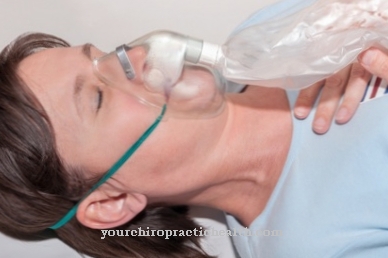Gait disorders are not uncommon, but can be traced back to a large number of causes, which on the one hand require very different treatments and on the other hand are difficult to prevent.
What are gait disorders?

Gait disorders are movement disorders that cause the walking movement to deviate from its typical pattern. However, a distinction must be made between gait disorders and restricted mobility. Gait disorders can therefore be revealed by a slight limp, but also by disorders that make walking hardly possible.
Their causes are particularly diverse and result in very different treatment methods. The success of the treatment is as varied as the treatment methods. Some gait disorders can be completely eliminated, others can only be greatly or slightly minimized.
causes
There are a number of very different causes for gait disorders. On the one hand, gait disorders can occur when muscles or bones are injured, malformed or affected in any other way. In this case, medicine speaks of orthopedic causes.
If a disease of the internal organs triggers a gait disorder, internal causes are spoken of. If the gait disorders are due to damage to the nerves, they are referred to as neurological causes. Since an orthopedic, an internal or a neurological cause can be subject to a gait disorder, a number of very different triggers come into question.
Typical orthopedic causes are bone problems such as fractures, muscle injuries such as strains or tears, spinal diseases such as herniated discs or joint diseases such as osteoarthritis. Internal causes can be circulatory disorders or thrombosis, but also too low or too high blood pressure, lack of fluids, dizziness, alcohol and other poisons, cardiovascular diseases, sunstroke and others. Neurologically induced gait disorders can be attributed, for example, to diseases such as multiple sclerosis, Parkinson's or epilepsy.
Diseases with this symptom
- Broken bone
- Femur fracture
- Circulatory disorders
- Alcohol addiction
- Cardiovascular diseases
- Muscle spasms
- Fracture of the lower leg
- Muscle strain
- thrombosis
- stroke
- Heart attack
- multiple sclerosis
- disc prolapse
- arthrosis
- high blood pressure
- Pericarditis
- Diabetic foot syndrome
- Parkinson's
Diagnosis and course
A gait disorder is clearly indicated by a disorder of the musculoskeletal system and is therefore easy to diagnose by a doctor. Finding out the exact cause of the gait disorder, on the other hand, is sometimes much more difficult. To do this, the doctor asks the patient about recent accidents, previous illnesses, paralysis and symptoms of paralysis, complaints such as dizziness and sensory disorders, alcohol consumption or medication.
This is followed by a physical examination to determine the type and severity of the gait disorders. Thereafter, the reflexes, motor skills and feelings of the patient are usually examined with a neurological examination in order to check whether neurological causes could be responsible for the gait disorder. To do this, the patient must perform a series of exercises.
Coordination exercises, for example, show whether a disorder of the sense of balance is present or can be excluded. Hearing tests, blood tests, computed tomographs, magnetic resonance imaging, electroencephalographs, cerebral water tests and other procedures can also be used for diagnosis. Depending on how severe the gait disorder is and how difficult it is to determine its causes, a family doctor may refer the patient to a specialist.
Depending on the cause of a gait disorder, the gait disorder can take a different course. A simple fracture, a pulled muscle or other causes heal on their own in some cases, and the gait disorders disappear again. Usually, however, a gait disorder needs to be treated by a doctor.
Complications
Gait disorders can have very different causes. Usually the musculoskeletal system is impaired and sometimes the sense of balance is disturbed. However, it can also be caused by a brain disease, such as a brain tumor or a stroke. The patient should therefore always go to the doctor, he will precisely determine the cause of the gait disorder. The doctor can now initiate therapy.
If the gait disorder is due to the musculoskeletal system, surgery can help, but complications can also occur here. It cannot be ruled out that viruses and bacteria influence healing. However, it is also possible that the body will not accept a prosthesis. Nevertheless, it is the most successful therapy to eliminate the gait disorder. Physiotherapy is also recommended for some illnesses, here the balance and muscles are trained. These exercises should also be carried out at home in order to alleviate the gait disturbances.
In the case of certain diseases, no cure is sought; the gait disorder can only be stopped here, such as in Parkinson's or multiple sclerosis. However, if the cerebellum is damaged, the doctor cannot do anything and the gait disorder remains. Here the patient can only train the gait and prevent a possible fall. Those affected often avoid walking and no longer move outside the home. This is wrong, because this is how the last physical reserves are depleted and the patients become socially isolated. This has a bad effect on the overall prognosis, and depression is often added.Therefore, people should train the gait even if it is difficult.
When should you go to the doctor?
Since gait disorders can be the symptom of various diseases, an accurate diagnosis by the doctor is particularly important. Because a timely discovery increases the chances of recovery and thus the success of the treatment. Going to the doctor should therefore be started immediately if the disturbance occurs suddenly and obviously without any external cause.
Those affected who have no relevant previous illnesses should therefore not hesitate. This particularly includes cases in which pain-free movements can no longer be performed independently. Otherwise there is a risk of further injuries from falling, which will exacerbate existing symptoms and make everyday life considerably more difficult. A visit to the doctor, however, is less urgent if treatment is already taking place and the attending physician has initiated the first treatment steps.
In these cases, a close consultation is still necessary. However, as a rule, it will only be necessary to go to the practice after the already known symptoms have worsened. If the gait disturbance is the result of an external cause (such as a fall or an accident), it is essential to see a doctor. You can only wait for a visit if you have symptoms that allow you to walk independently without major obstacles. However, a curative treatment is also necessary here, provided that there is no independent improvement.
Doctors & therapists in your area
Treatment & Therapy
The therapy of a gait disorder is of course based on the causes that caused the gait disorder. Since the causes can be as varied as in hardly any other disease, treatment is not only different if an orthopedic, internal or neurological cause is the trigger for the gait disorder.
Instead, treatment methods can vary widely within one of these three groups. Some causes such as circulatory disorders, high blood pressure and low blood pressure are usually treated with medication. Strokes and thromboses, however, can require surgery in addition to medication. If alcohol, smoking or other poisons are the cause of the gait disturbances, in many cases not using these agents will help.
For many orthopedic causes, immobilization of the affected bones or muscles is sufficient to guarantee a successful healing process. In some cases, however, drugs are prescribed or physical therapy and other measures are ordered instead. In some cases, the gait disorder can only be treated with surgery. Neurological causes are often particularly difficult to treat, because often only the symptoms can be reduced, but not the cause.
Outlook & forecast
A general prognosis cannot be made for gait disorder because it is very individual and depends on numerous factors. If the gait disorder is due to a lack of nutrients and the deficiency is corrected, the gait disorder will in many cases improve rapidly and often go away completely.
There is currently no causal treatment for Parkinson's disease. However, the gait disorder in Parkinson's disease can be improved by taking medication. Especially in the early stages of the disease, drug therapy often brings about a significant improvement in symptoms. However, as the disease later progresses, the gait disorder may no longer be avoidable. If treatment begins on time, a normal lifespan is possible despite Parkinson's.
With multiple sclerosis, the prognosis for men is worse than for women. However, other factors play an important role in the outlook, such as the age at the disease, the number of inflammation foci, and which areas of the central nervous system are affected by multiple sclerosis.
Problematic alcohol consumption can also cause gait disorders. It often begins in adolescence. However, the majority of adolescents also abandon the harmful use of alcohol without intervention. Alcohol addiction can be phased or continuously worsen. Around 20% of those affected recover without help - with treatment, this number is between 40% and 75%, depending on the study.
prevention
Gait disorders with neurological causes often cannot be prevented. However, the risk of developing a gait disorder that has internal or orthopedic causes can be at least partially minimized through a healthy lifestyle. Refraining from alcohol and nicotine, getting enough exercise, refraining from particularly dangerous sports, observing safety precautions in everyday life, such as correctly warming up before and using leg protectors during sports or similar, are helpful methods to prevent gait disorders, however never completely exclude.
You can do that yourself
As a rule, gait disorders can only very rarely be treated by self-help. In most cases it is necessary to see a doctor. Surgical treatment is often necessary and treatment with medication is only used in a few cases. The gait disorders often occur in old age and can greatly influence and limit the patient's everyday life.
Various walking aids can be used for gait disorders. This includes, for example, a walking stick, a walker or a wheelchair. These devices make it easier for the person concerned to move around, so that normal everyday life is possible again. Gait disorders can be prevented through sporting activities. Even in old age, sporting activities have a positive effect on gait disorders and can prevent and limit them. Rehabilitation sports and gymnastics can help to strengthen the muscles and minimize deficits in posture in order to alleviate the symptoms of gait disorders.
However, gait disorders can also be triggered by psychological problems. Again, no self-help methods are possible. The patient should definitely seek medical treatment. If the gait disorders also cause great pain, a doctor must also be consulted. Without treatment, the pain can worsen and lead to the former medical complications.






.jpg)




















